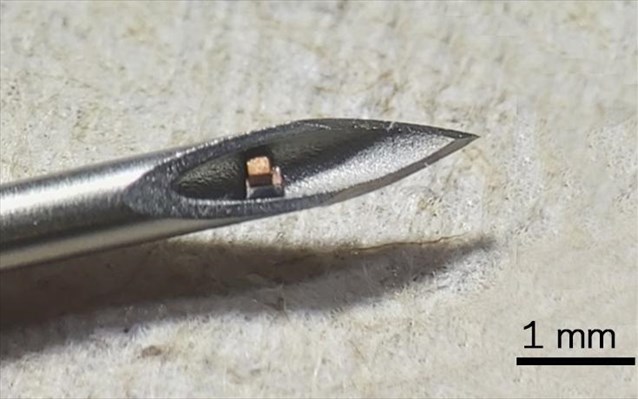 The world's smallest single-chip system, sits on the tip of a hypodermic needle - Chen Shi/Columbia Engineering
The world's smallest single-chip system, sits on the tip of a hypodermic needle - Chen Shi/Columbia Engineering
The continuing miniaturization of electronics is opening up some exciting possibilities when it comes to what we might place in our bodies to monitor and improve our health. Engineers at Columbia University have demonstrated an extreme version of this technology, developing the smallest single-chip system ever created, which could be implanted with a hypodermic needle to measure temperature inside the body, and possibly much more.
From ladybug-sized implants that track oxygen levels in deep body tissues to tiny "neural dust" sensors that monitor nerve signals in real time, scientists are making big steps when it comes to the functionality of tiny electronic devices. The implant developed by the Columbia Engineers breaks new ground as the world's smallest single-chip system, which is a completely functional electronic circuit with a total volume of less than 0.1 mm3.
That makes it as small as a dust mite, and only visible under a microscope. The tiny chip required some outside-the-box thinking to make, particularly when it comes to the way it communicates and is powered.
Where small electronics might feature radio frequency (RF) modules to transmit and receive electromagnetic radio signals, these wavelengths are too large to be used with a device this small. Ultrasound wavelengths, on the other hand, are far smaller at a given frequency, as the speed of sound is far less than the speed of light that the electromagnetic waves travel at. So, the team incorporated a piezoelectric transducer that acts as an "antenna" for wireless powering and communication via ultrasound.
This combines with an onboard low-power temperature sensor to turn the chip into a probe for real-time temperature sensing, enabling it to monitor body temperature and also fluctuations in temperature driven by the therapeutic application of ultrasound. The implant's capabilities were demonstrated in live mice where it was used for ultrasound neurostimulation, and up to seven were implanted into the mice at a time via intramuscular injection with a syringe.
The scientists imagine these types of chips being implanted into the human body, and then wirelessly communicating information on what they measure via ultrasound. In its current form this is limited to body temperature, but other possibilities include blood pressure, glucose levels and respiratory function.
"We wanted to see how far we could push the limits on how small a functioning chip we could make," says the study's leader Ken Shepard. "This is a new idea of 'chip as system' – this is a chip that alone, with nothing else, is a complete functioning electronic system. This should be revolutionary for developing wireless, miniaturized implantable medical devices that can sense different things, be used in clinical applications, and eventually approved for human use."
The research was published in the journal Science Advances.
Update (May 13, 2021): This article originally compared the volume of this chip to the world's smallest computer. This comparison and the volume of the computer were incorrect and has now been removed from the text. We apologize for the error and thanks to the reader who pointed it out to us.
Source: Columbia University, newatlas.com



